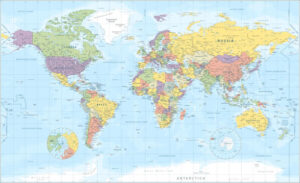Introduction
- Overview of the article’s Top 5 Worst Places in the World to Live purpose: The introduction will briefly explain that the article aims to explore Top 5 Worst Places in the World to live in the world and highlight the disparities in living standards across nations.
Global Living Standards and Disparities

- Progress in global living standards: This section will discuss the overall improvement in global living standards over time, highlighting advancements in areas such as healthcare, education, and technology.
- Disparities in progress among nations: It will delve into how despite global progress, not all countries have experienced the same level of development, leading to significant disparities in living conditions.
- Factors affecting living standards: This part will explore various factors influencing living standards, including access to opportunity, infrastructure, and security, and how these factors contribute to a country’s ranking among the worst Places in the World to live.
Historical Context: Impact of Colonialism
- A. Concentration of worst countries in Africa: This section will discuss the prevalence of countries in Africa among the Worst Places in the World and examine the historical context behind this phenomenon.
- Examination of colonial history’s impact on the current state: It will delve into the lasting effects of colonialism on the economies, societies, and infrastructures of many developing countries.
- Example of India’s colonial history and subsequent struggles: Using India as an example, this part will illustrate how colonial rule has contributed to long-term challenges in achieving prosperity.
Emigration Trends:
- Influence of historical events on emigration: This section will explore how historical events, such as wars, conflicts, and economic downturns, have driven emigration from certain countries.
- Economic factors driving emigration: It will discuss economic factors, including lack of job opportunities, poverty, and income inequality, as significant drivers of emigration.
- Examples of countries experiencing significant emigration: This part will provide examples of countries experiencing high levels of emigration and discuss the reasons behind this trend.
Top Emigration Destinations:
- Mention of India, Pakistan, Bangladesh as top emigration destinations: Here, we’ll highlight these countries as significant destinations for emigrants and discuss the factors attracting people to these regions.
- Reasons for emigration to these countries: It will explore the reasons why individuals choose these countries as destinations for emigration, such as economic opportunities, quality of life, and access to public facilities.
- Other countries attracting immigrants for economic opportunities: This section will briefly mention other countries, such as South Korea and other growing economies, that attract immigrants seeking better economic prospects and living standards.
The study of methodology
To determine Top 5 Worst Places in the World to Live in, we first looked at our rankings of the world’s poorest countries, countries with the highest emigration rates, countries with the lowest life expectancy, and the world’s most hazardous countries. We then utilized the average ranking of all these articles to produce a score for each country to determine the world’s worst countries right now, in order of highest to lowest score. Of course, with the proper actions in the future, many of them could potentially improve their economic status and style of life, allowing them to move off our list.
Follow the website for more details
Following are The Top 5 Worst Places in the World to Live
5. Burkina Faso

- Ranking of the poorest countries: 25.
- Life expectancy rank: 12
- Emigration rate ranking: 39.
- Dangerous countries rank: 29.
Burkina Faso is currently in chaos, with armed Islamist groups committing lethal attacks and the government losing some power to such organizations, according to Human Rights Watch. However, Burkina Faso’s growth rate remained at 6.9% in 2021, however it fell to 2.5% in 2022.
4. Mali

- Poorest countries ranking: 22
- Life expectancy rank: 9
- Emigration Rate Ranking: 54
- Dangerous Countries Ranking: 3
Many African nations, including Mali, are afflicted by militant Islamist groups. With Mali’s military junta tightening control, the country may be a dangerous investment, with modest growth of 3% to 4% expected in 2021 and 2022.
3. Democratic Republic Of Congo

- Poorest countries ranking: 24
- Life expectancy ranking: 11
- Emigration rate ranking: 49.
- Dangerous Countries Ranking: 2
Several internal conflicts have plagued the Democratic Republic of Congo for decades, contributing significantly to its ranking as one of the world’s worst countries. DRC was also severely damaged by Covid-19, but returned well in 2021, with a growth rate of 6.2% in 2021 and 8.9% in 2022, demonstrating how profitable and dangerous it is to invest in such economies.
2. Somalia

- Poorest countries ranking: 4
- Life expectancy rank: 6
- Emigration rate ranking: 38.
- Dangerous Countries Ranking: 5
Somalia, regarded as one of the most corrupt countries in the world, is home to one of the world’s most severe humanitarian crises, the result of decades of conflict. Despite these challenges, it is expected to expand at 4% in 2021, up from 7.5% in 2019 prior to the pandemic.
1. Afghanistan

- Ranking of the poorest countries: 9
- Life expectancy ranking: 28.
- Emigration rate ranking: 7.
- Dangerous Countries Ranking: 4
Afghanistan is at the top of the list of Top 5 Worst Places in the World to Live, and it is now in a dreadful position. Afghanistan has been plagued by civil strife for decades, and the Taliban’s rise to power in the early 2000s, followed by the United States’ invasion, debilitated an already impoverished nation. However, matters worsened in 2021 when the United States abandoned Afghanistan without a viable plan, resulting in the Taliban reclaiming control and Afghanistan’s economy plummeting by 20.7%.
9 best yoga position that help students become more concentration
Conclusion
- Summary of key points: The conclusion will summarize the main points discussed in the article, emphasizing the disparities in living standards, the historical context of colonialism, emigration trends, and top emigration destinations.
- Final thoughts on global living standards and emigration trends: Here, we’ll offer some final reflections on the broader implications of global living standards and emigration trends, highlighting the need for addressing inequalities and promoting sustainable development worldwide.
